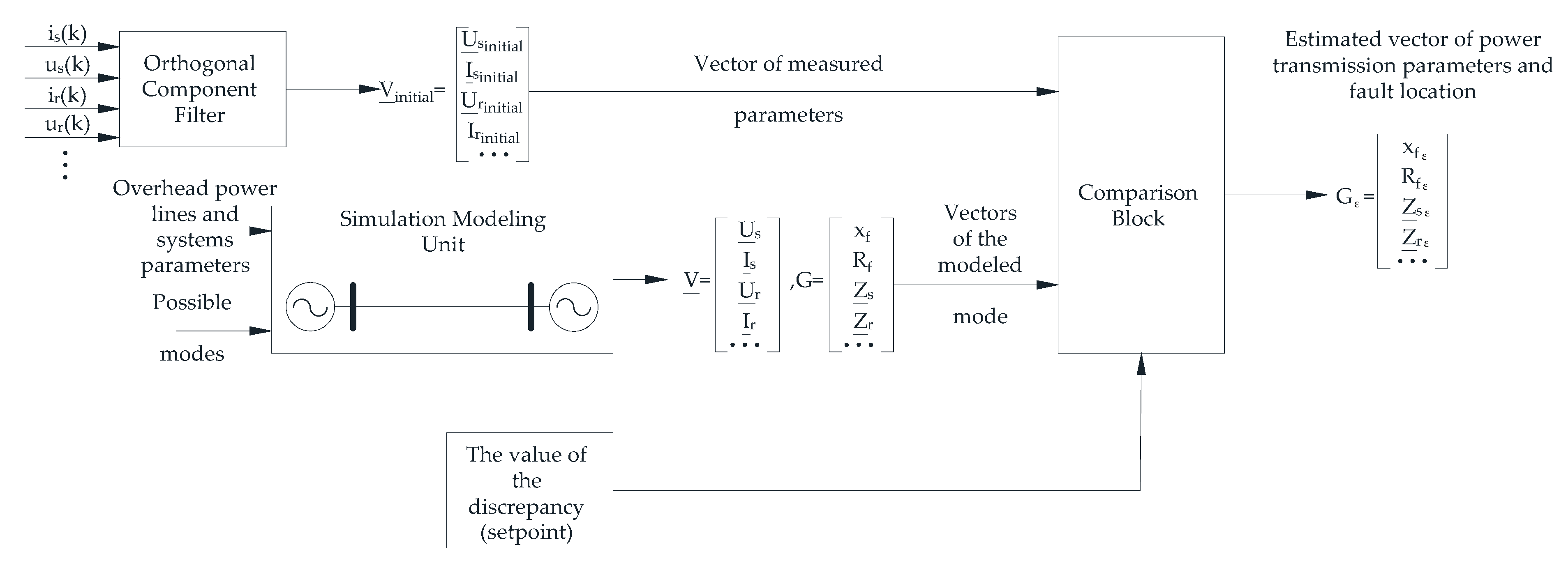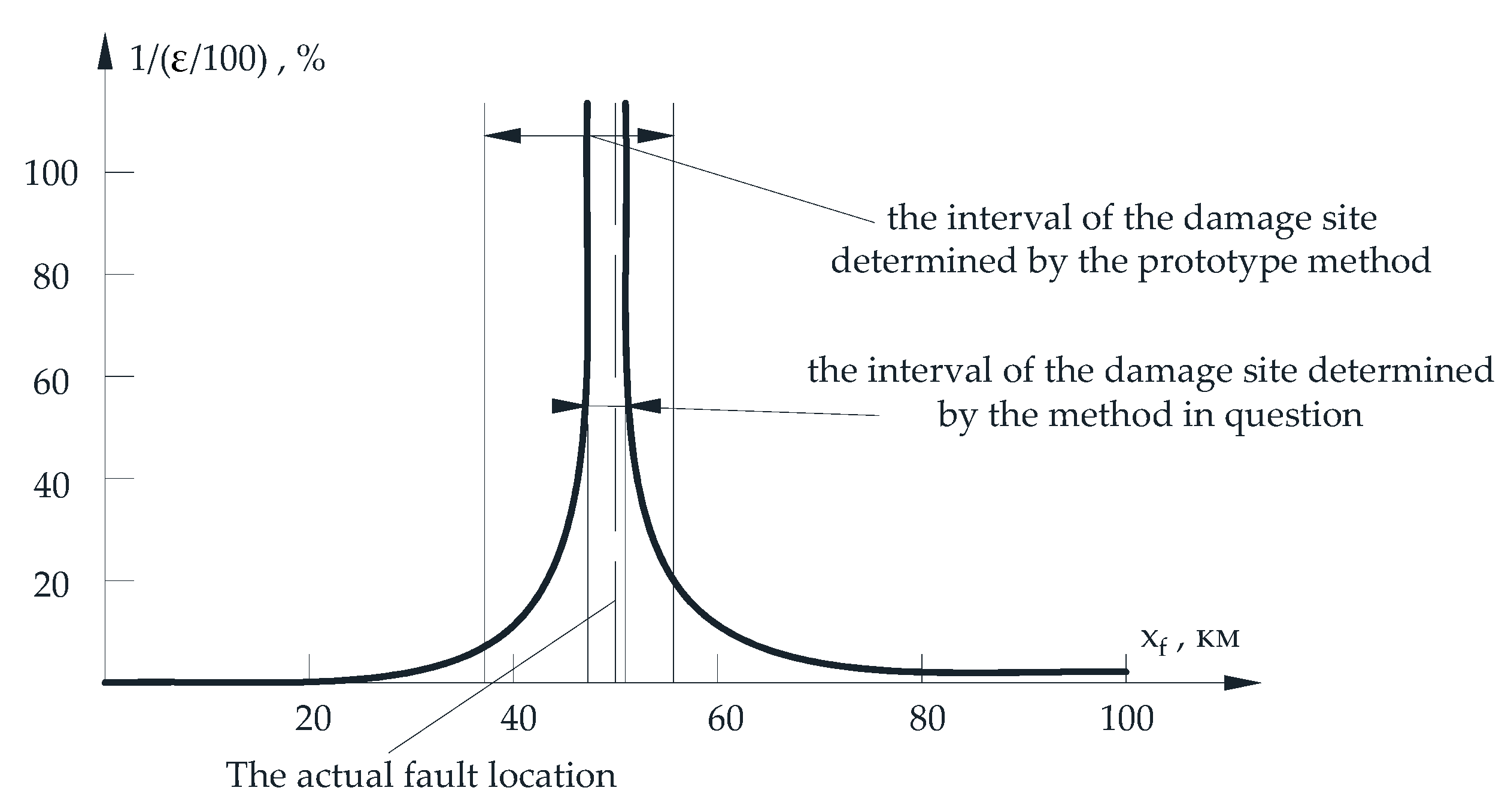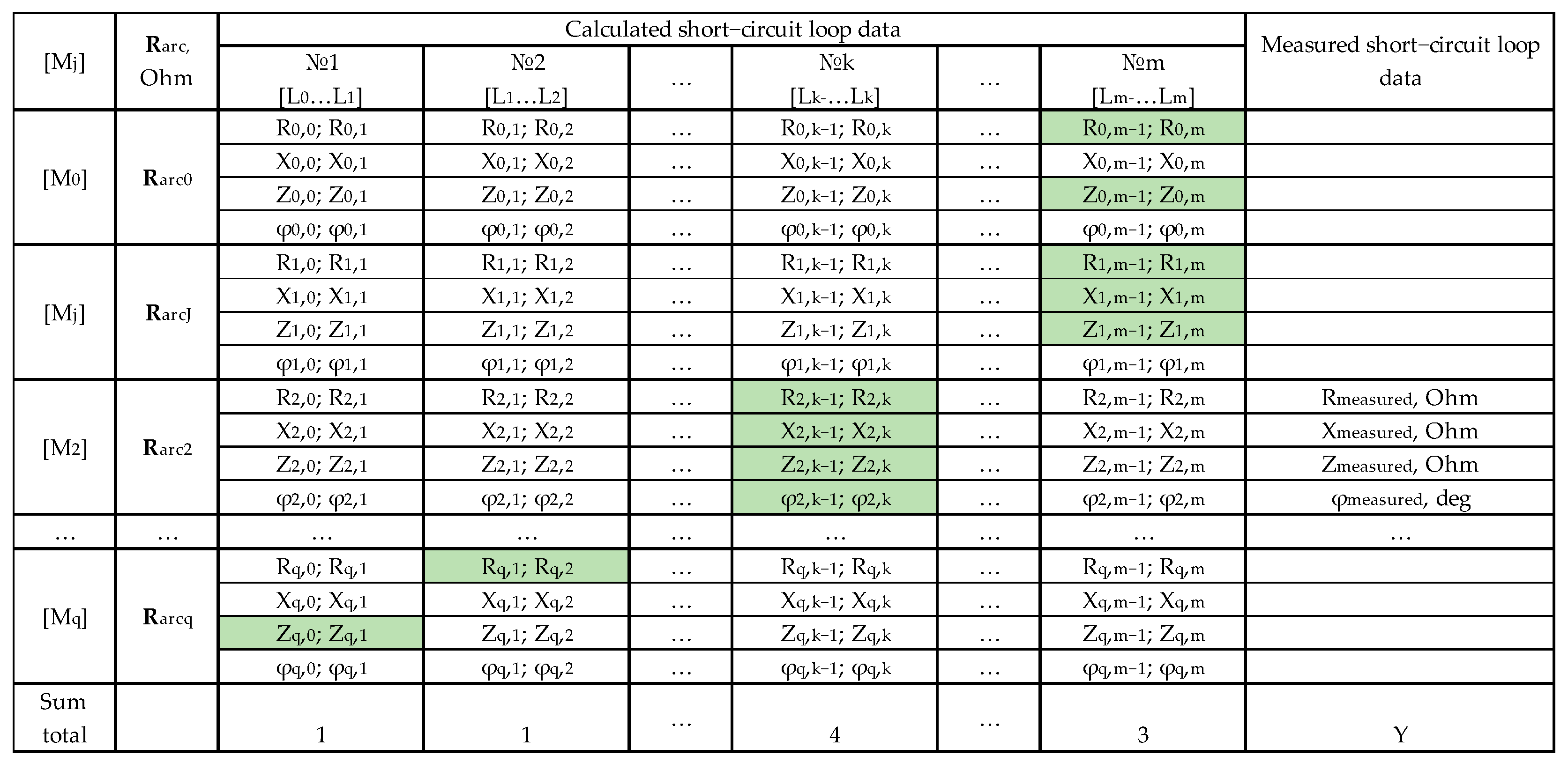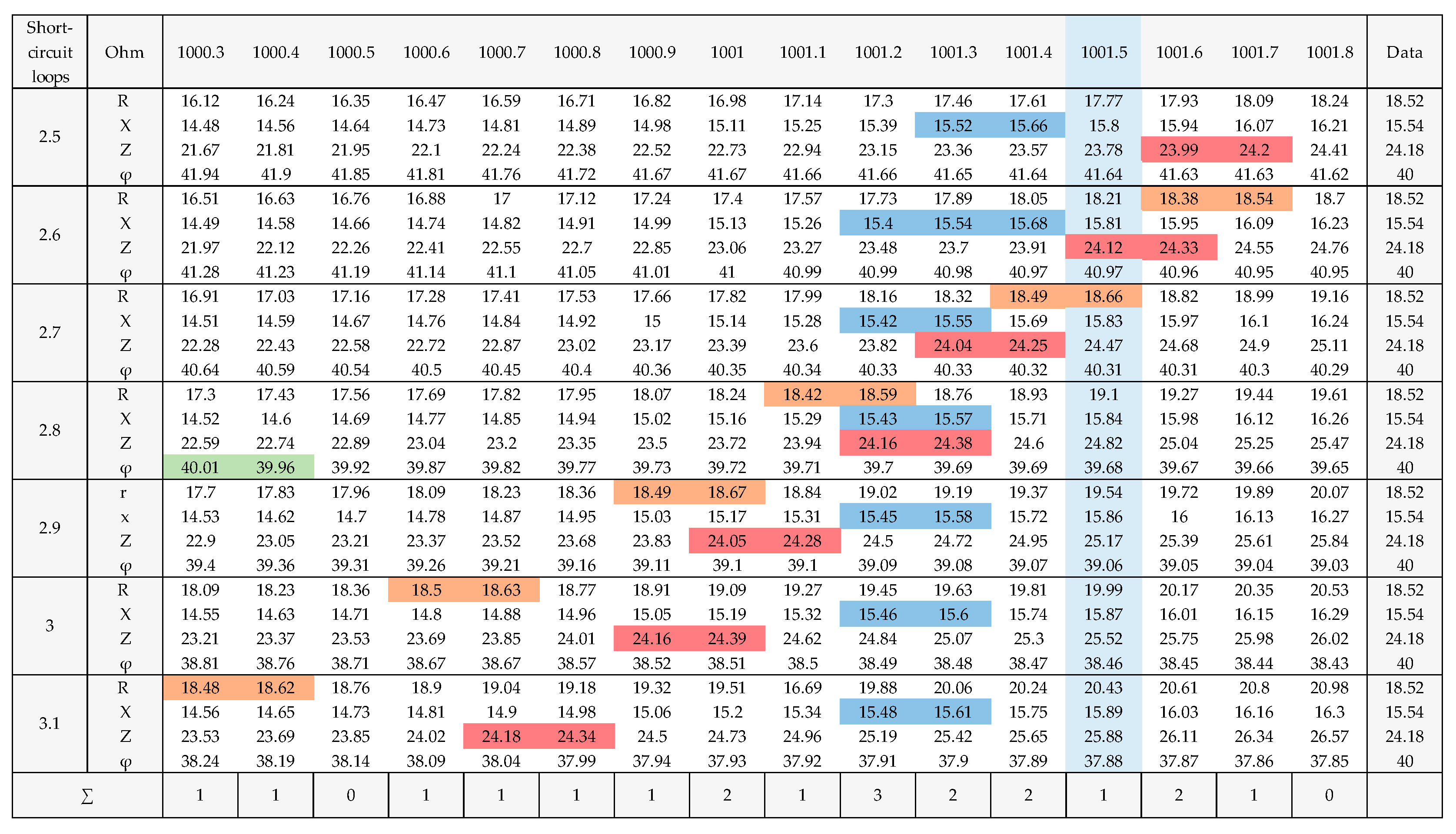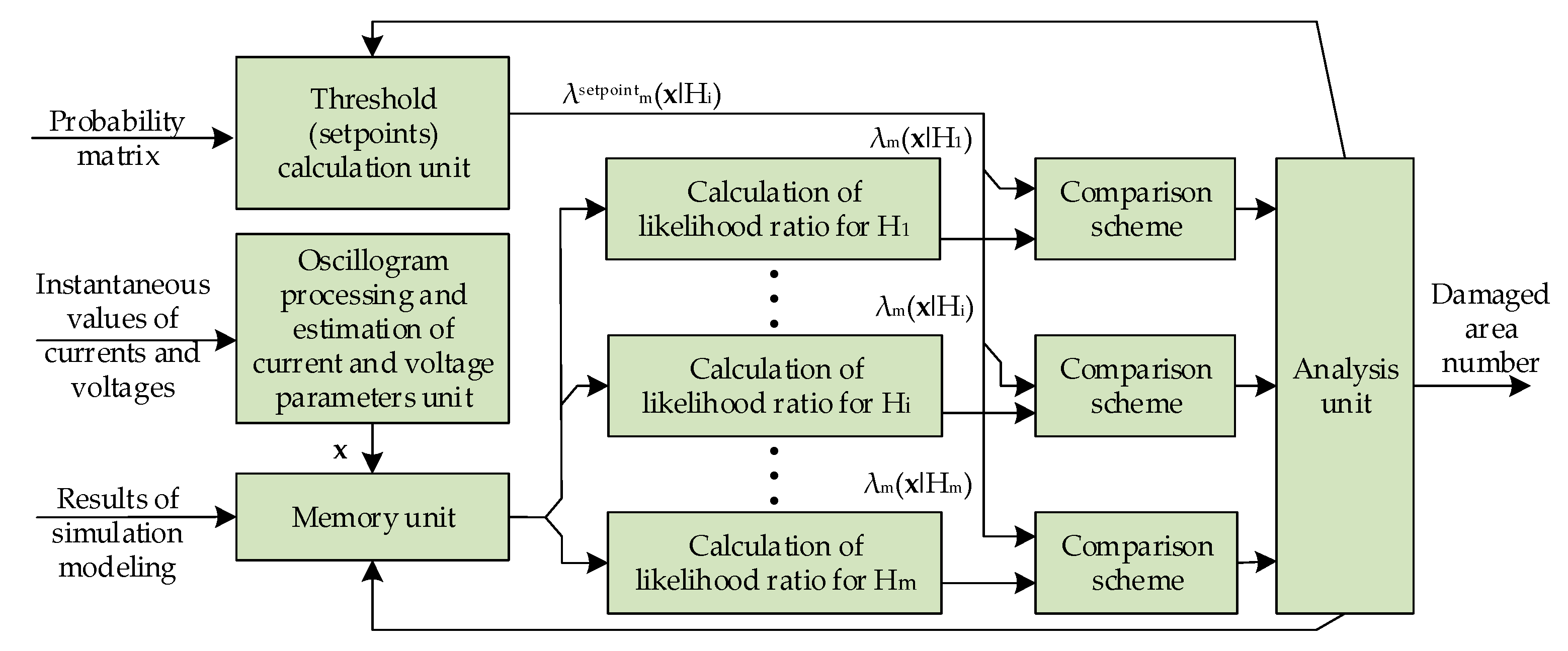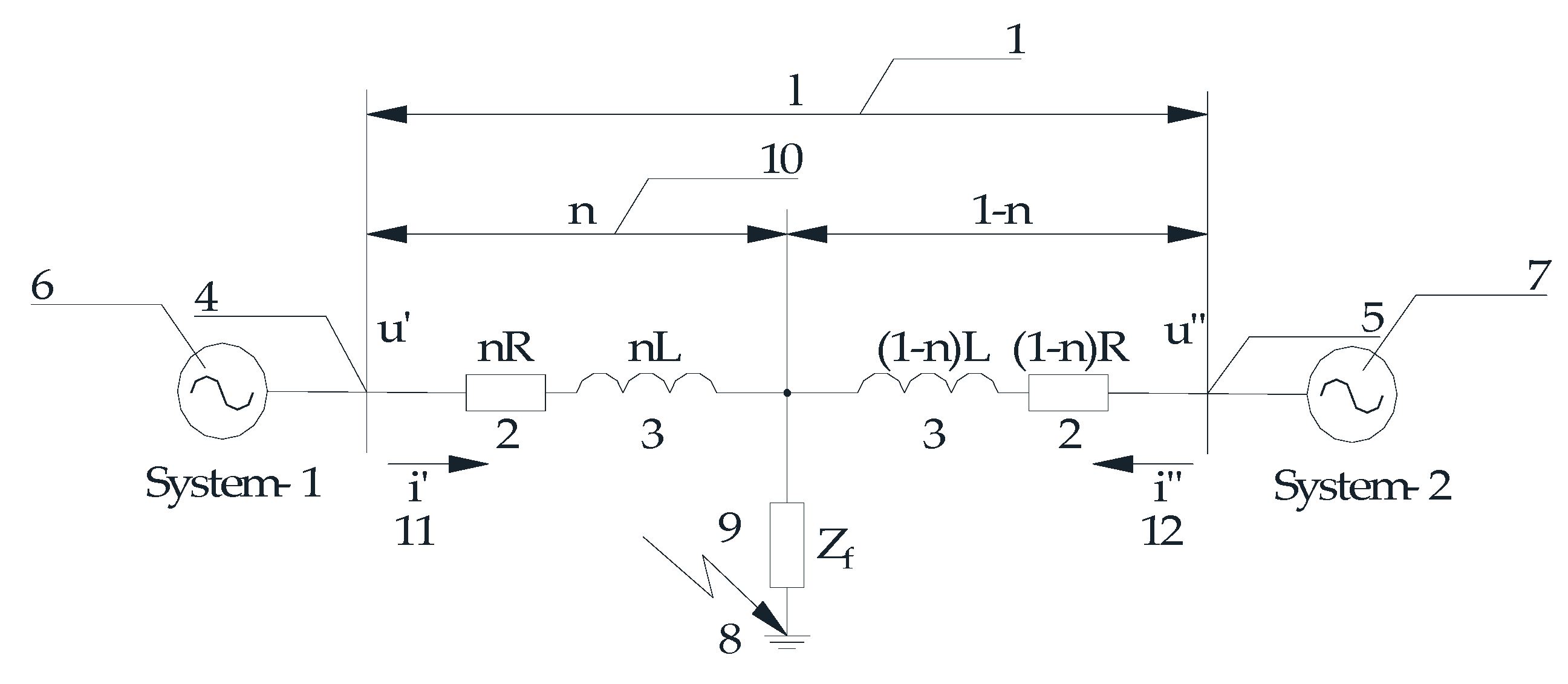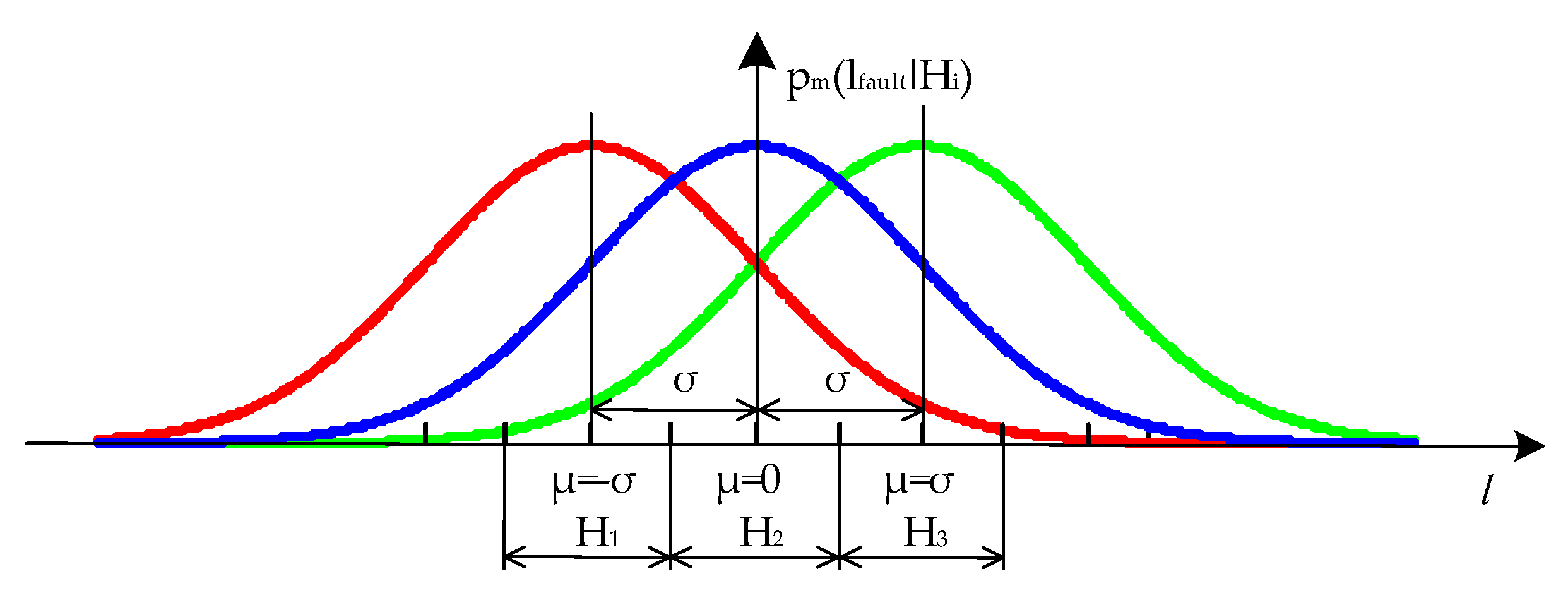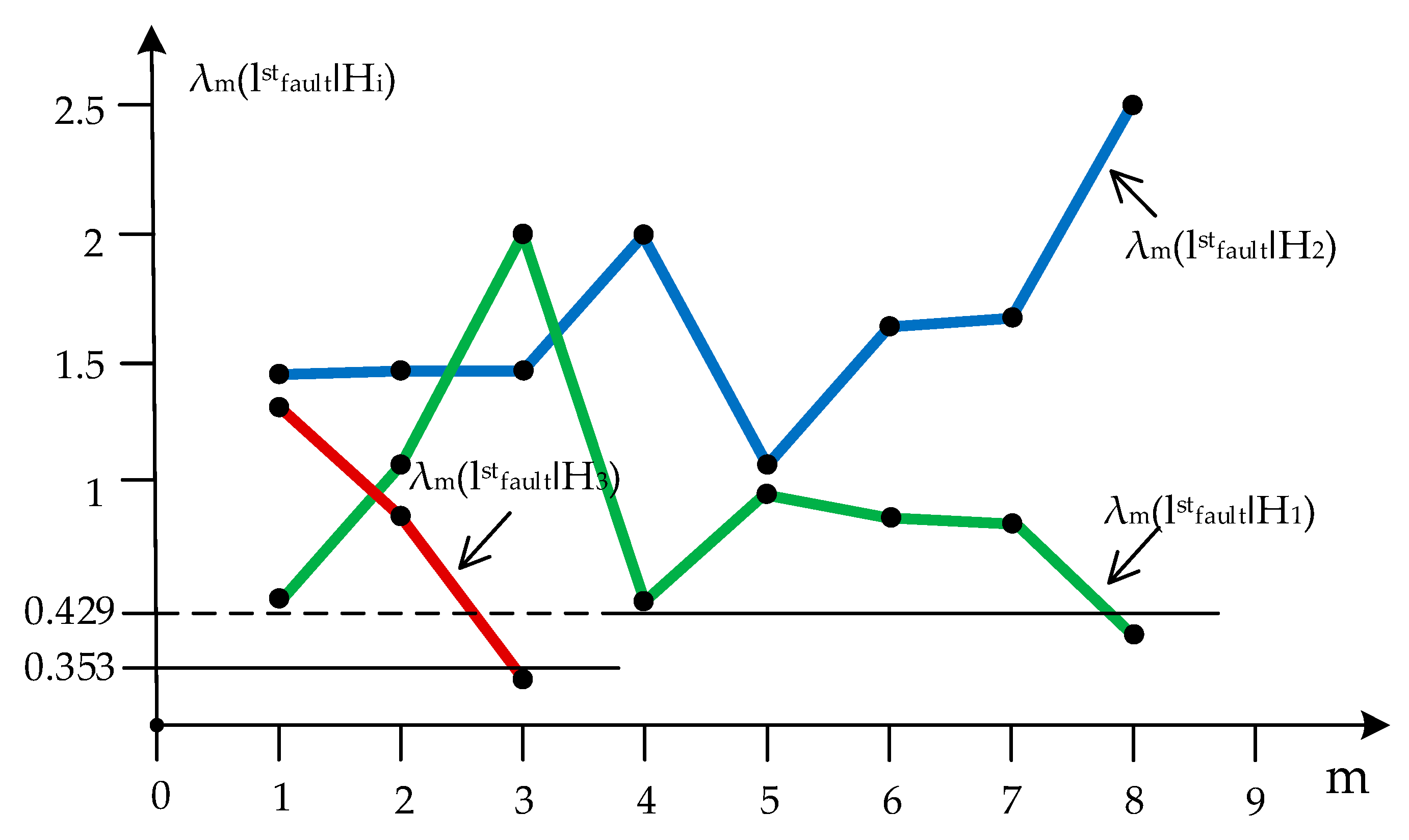1. Introduction
Overhead power lines (OHPLs) form the backbone of electric power systems, connecting generation sources with consumers. The reliability of their power supply and the maintenance costs of power grids are largely dependent on accurate fault location (FL) on OHPLs, as it significantly affects the speed of power supply restoration and reduces equipment downtime [
1,
2,
3].
It should be noted that a large part of OHPL outages are transient, meaning that the OHPL remains in operation after a successful automatic reclosure. These transient faults can be self-clearing or, under certain conditions, can develop into permanent faults. On OHPLs, unstable faults can be caused by the following: the throwing of various objects on wires, power overlapping in suspension insulator garlands, the convergence of phase wires under windy conditions or “wire dancing”, and others. In this case the procedure of fault searching during the post-accident bypass of OHPLs becomes much more complicated, and the importance of developing accurate and reliable methods and devices for FL increases [
4,
5,
6,
7,
8,
9,
10,
11,
12].
The development of FL devices can be performed using various physical principles and algorithms. The relative error of traveling wave methods in FL [
13,
14,
15,
16,
17], including those based on the active probing of OHPLs [
17], is significantly lower than the error of traditional FL devices based on emergency mode parameters (EMPs) [
18,
19,
20,
21,
22]. However, the high cost of wave-based FL devices still limits the possibility of their mass application.
Table 1 provides an overview of the main categories of existing FL methods with their main advantages and limitations, which is based on an analysis of sources [
3,
4,
5,
6,
7,
8,
9,
10,
11,
12,
13,
14,
15,
16,
17,
18,
19,
20,
21,
22].
When implementing an FL system, it is crucial not only to accurately estimate the fault point on the OHPL but also to establish an appropriate inspection zone for the line crew(s) [
1,
2,
9]. This zone must satisfy two conflicting requirements. On the one hand, it must be sufficiently large to ensure that the actual fault location falls within its boundaries, accounting for the influence of random factors. On the other hand, it should be as small as possible to minimize the time and economic costs associated with inspecting the line. Consequently, defining this zone requires careful consideration of the OHPL design specifics and the full range of random factors that affect FL accuracy.
According to Russian regulatory documents, the following requirements have been established for determining the OHPL inspection zone. Following an emergency shutdown, the maximum extent of this zone must be calculated based on the readings from the FL devices:
±15% of the OHPL length for lines up to and including 50 km;
±10% for OHPLs over 50 km up to and including 100 km;
±7% for OHPLs from 100 to 300 km inclusive;
±5% for OHPLs with a length of 300 km or more.
However, when determining the OHPL bypass zone, refs. [
8,
10] do not take into account the FL errors, those associated with power quality indicator (PQI) deviations. Such deviations can be caused by the presence of harmonic components caused by transients during short circuits on OHPLs in the current and voltage emergency oscillograms, the non-stationarity of industrial load power consumption influence, the use of power electronics elements, the presence of renewable energy sources with stochastic nature of power generation, etc.
Let us formulate the FL location problem as a classification task which involves determining whether a fault belongs to one of the segments within the OHPL inspection zone. Due to the influence of the random factors mentioned above, the decision-making process in FL determination is stochastic. It involves processing current and voltage emergency oscillograms recorded over a limited time interval.
Furthermore, the following considerations contribute to the multi-stage nature of decision making in OHPL fault location [
15,
20,
23]:
Using complete parameter arrays. It is advantageous to use full sets of current and voltage parameters from the entire emergency event recording, rather than basing the fault location decision on a single time slice of an oscillogram.
Adaptive parameter selection. The approach allows decisions to be made using either a reduced set of parameters when signal distortions are minimal or an extended set for severe (“deep”) distortions. This ensures accurate faulted section identification with the required reliability indicators while optimizing computational time and resources.
Data source integration. The methodology supports the use of emergency oscillograms (or fault location results) from various devices—such as dedicated FL units, fault recorders, protection relays, automation terminals, energy management systems, and synchrophasors—located on adjacent OHPL sections that recorded the event.
This paper analyzes established methods for identifying the faulted section in an OHPL and investigates the application of multi-hypothesis sequential analysis to this problem, using Reed’s algorithm as a case study.
3. Consistent Criterion for Selecting a Hypothesis About a Faulted Section from a Set of Overhead Transmission Line Sections Within Its Bypass Area
It is assumed that k experiments with sampled data at each step of the procedure are conducted to perform sequential analysis for selecting the faulted section within the OHPL bypass zone.
Based on the each of the experimental results, one of (M + 1) decisions is made:
To end the experiment by accepting hypothesis H1 (site number 1 is faulted);
To end the experiment by accepting hypothesis H2 (site number 2 is faulted);
To finish the experiment by accepting hypothesis HM (site number M is faulted);
…;
To continue the experiment by making additional observations.
Thus, the procedure is performed sequentially: based on the first observation, one of (M + 1) decisions is made, and when one of the first M decisions is selected, the process ends. If the decision number (M + 1) is selected, the next (second) observation is made. Now one of the (M + 1) decisions is made based on the first two sample values. If the choice is the last (M + 1) decision, a third experiment is performed. The process continues until one of the first M solutions is selected. The number of hypotheses corresponds to the number of OHPL length partitions, which are selected based on operational requirements. Ideally, the section length corresponds to the span length (the distance between transmission line supports).
In the general case, the decision concerning the faulted section is made on the basis of the current and voltage parameter x vector, characteristic and corresponding to the faulted section with the number m (m = 1, …, M). In this case, the current and voltage parameter vector x = {x
1, x
2, …} is generally random, because it can include distorting components, for example, associated with electric power quality indicator (PQI) deviations from the normative values [
28].
Since hypotheses H1, …, Hm, …, HM mutually exclude each other and exhaust all possible cases for the selected vector x values, then one (and only one) of hypotheses H1, …, HM is consistent with a particular set of vector x values.
It should be added that it is possible to numerically express the significance of economic losses due to various wrong decisions. Let us introduce the functions w1(x), …, wm(x), …, wM(x), where wm(x) is a non-negative function defining the additional economic costs associated with the extended OHPL bypass and resulting from hypothesis Hm, when the current and voltage parameter x vector is true. Obviously, wm(x) = 0 for all points x included in section m, since for such points, the correct decision regarding the OHPL faulted location will be made.
Note that the functions w1(x), …, wm(x), …, wM(x) correspond to the FL errors weight functions, since the numerical ratio w1(x), …, wm(x), …, wM(x), i.e., the ratio of fault location error prices, should determine the decision rule concerning the faulted OHPL section.
Risk R(x) for the current and voltage parametric point x we will call the mathematical loss expectation caused by incorrect decisions with respect to the faulted section, when the x concrete value is true.
Let the probability of accepting hypothesis H
m equal P
m(x) and the loss function associated with this decision equal w
m(x); then the risk (mathematical loss expectation) is equal to
We will assume that the optimal decision rule regarding OHPL faulted section m will minimize risk R(x) in case of making wrong decisions.
The selection and obtaining of functional dependencies w
1(x), …, w
M(x) from the practical point of view may present certain difficulties, and their application may lead to complex calculation algorithms. Therefore, it is reasonable to use rough approximations of such dependencies or simplifications. The most widely used approximation is the use of a “semi-simple cost function” [
29] corresponding to the following expression:
where c is a chosen positive constant, which, depending on w
m(x), can take only two values: 0 or 1. In some cases [
29], c = 1 is taken since multiplying the risk function by a constant multiplier does not affect decision rule realization. Further we will consider only semi-simple cost functions, since even the application of such functions allows for the implementation of higher-accuracy FL algorithms.
In sequential analysis procedures with simplified weight functions w
m(x), the concepts of preference and indifference zones are introduced [
29]. Thus, the preference zone for accepting hypothesis H
m is understood as the set of all parametric points x, for which w
m(x) = 0 and w
i(x) = 1 at i ≠ m. The set of points x for which w
m(x) = 0, w
i (x) = 0, and w
j(x) = 1 for j ≠ m,i is called the indifference zone of hypotheses H
m and H
i. Similarly, the set of points x for which w
m(x) = w
i(x) = w
j(x) = 0 and w
n(x) = 1 for n ≠ m,i,j is called the indifference zone of hypotheses H
m, H
i, H
j, etc.
Let us consider a simplified example to characterize the preference and indifference zones for FL. Assume a random distribution of FLs along the OHPL, as shown in
Figure 7, resulting from the influence of various random factors. The conformity of the estimated fault distance distribution function to a normal law in FL problems is confirmed in [
1]. We assume that the line inspection zone is determined by the “three-sigma” rule [
4,
30]; that is, it spans an interval of three root mean square (RMS) values of the distribution law in both directions from the estimated FL. For corrective action, this inspection zone is divided into three sections. The objective is to determine, based on consecutive measurements of current and voltage parameters and the subsequent distance calculation, in which section of the OHPL inspection zone the actual fault is located, accounting for distortions caused by the impact of random factors.
The following hypotheses are introduced regarding the OHPL fault location (
Figure 7): H
1—when the estimated FL l
fault < a; H
2—when the estimated fault location a < l
fault < b; H
3—when the estimated fault location l
fault > b. Let Δ be some positive value; then the weight functions characterizing the preference and indifference zones are defined as follows:
The delta (Δ) value determines the ambiguity of decision making and is related to the probability of the FL. The Δ variable is limited by the width of the statistical distribution (see
Figure 7).
The zone of preference for accepting hypothesis H1 is defined by the lfault point set, for which the condition lfault < a − Δ is satisfied. The zone of preference for accepting hypothesis H2 corresponds to the inequality a + Δ < lfault < b − Δ, and the zone of preference for accepting hypothesis H3 corresponds to the inequality lfault > b + Δ.
The indifference zone of hypotheses H1 and H2 is defined by the inequality a − Δ < lfault < a + Δ, the indifference zone of hypotheses H2 and H3 is defined by the inequality b − Δ < lfault < b + Δ, and the indifference zones of hypotheses H1 and H3, as well as H1, H2, and H3, are absent.
It is important to note that the weight functions w
1(x), …, w
M(x), which determine risk R(x), have a simple form and can take only two values: 0 or 1. Therefore, the expression for risk (1) is transformed into the following form:
where the summation is performed only on the m values for which w
m(x) = 1.
Thus, a wrong decision is made only when hypothesis Hm, for which wi(x) = 1 when i ≠ m, and risk R(x) in this case are equal to the wrong decision probability.
4. Recognition Ability Indicators of Sequential Analysis Algorithms in Overhead Power Transmission Line Fault Location Implementation
In order to form a rational decisive rule, it is necessary to introduce efficiency indicators of the sequential procedure for locating a faulted section. It is reasonable to introduce three main indicators groups: probabilistic, economic, and informational.
The most general probabilistic effectiveness indicator is the conditional probability matrix for M hypotheses, each of which corresponds to a different faulted section within the OHPL bypass zone.
where i, k = 1, …, M and P(k|i) = P
i(k) = P
ik is the conditional decision-making probability on the number of faulted site k under the condition that the damage belongs to site i.
A generalized economic efficiency indicator in classifying faulted areas is the decision error cost matrix ||r
ik||. Based on such matrix, we can introduce the average risk as the average fault cost of a multi-hypothesis sequential analysis procedure.
It is important to consider that classification errors may have unequal impacts when calculating damage indicators. Clearly, the additional costs associated with an extended inspection of the OHPL—resulting from an incorrect identification of the faulted section—depend on factors such as complex terrain, the equipment used for inspection, and the presence of water obstacles, roads, and access routes to the OHPL. Furthermore, based on statistical data on power line failure rates and potential threats at specific sites, the a priori probabilities (Pi) characterizing the fault likelihood for individual sections may also be unequal.
To reduce the computational cost of implementing classification algorithms, many technical problems [
7,
9] use cost matrix modifications by introducing unit (simple cost matrices) or diagonal (semi-simple cost matrices) matrices considering that (expression (8)) r
ii = −1 or r
ii = −r
i. Here, negative values of (−1) and (−r
i) indicate “premiums” for correct decisions, and zero values correspond to incorrect decisions. However, the different values of correct decisions may still hold. Expression (8) for the average risk is transformed into the following form:
With equal a priori probability (P
i = 1/M) of fault in OHPL sections, a convenient characterization is the total probability of classification error:
Informational classification indicators are based on the current and voltage parameters estimated from emergency event oscillograms and correspond to the degree of uncertainty reduction in the process of decision making about the faulted OHPL. The amount of information to be extracted when locating the i-th OHPL section can be determined by the ratio of a priori P
i and a posteriori P
ii probabilities as follows:
The total potential amount of extracted information for all OHPL sections is determined by the formula expression
It is important that the amount of extracted information depends not only on the instantaneous values (parameters) of emergency event oscillograms but also on algorithms for their digital processing. For example, in industrial power supply systems, under conditions of electric PQI deviation from the normative values and recorded current and voltage distortions, it is advisable to introduce special digital processing algorithms to ensure the calculation of the required indicators for locating faulted sections [
31].
5. Algorithm and Device for Multi-Hypothesis Sequential Analysis
One way of organizing multi-hypothesis sequential analysis was proposed by Reid [
32]. Let x
1, x
2 … be sequence of variables and p
m (x
1, x
2 … |H
i) = p
m(x|H
i) be the joint probability density of x
1, x
2 … under the assumption that hypothesis H
i is true.
Reid’s decision algorithm is based on the generalized likelihood ratio formation at each step m
Those OHPL sections that least fit the fixed set of emergency event oscillogram parameters are sequentially excluded from the analysis when organizing FL. The decisive statistic λm(x|Hi) is calculated and compared with the threshold (setpoint) value λsetpointm (x|Hi) of the stopping boundary corresponding to the i-th OHPL section during the sequential analysis procedure. Thus, if λm(x|Hj) < λsetpointm (x|Hj), (j = 1, …, M), then a decision is made to continue observation, and the j-th OHPL segment is excluded from the subsequent analysis. The procedure of faulted section identification continues until the last most probable OHPL section remains, which is considered to be faulted.
In performing the sequential procedure process, the stopping boundaries for each of the analyzed OHPL sections are calculated based on the given probabilistic quality indicators of faulted section classification. According to [
32], the stopping boundary is defined by the following equality:
where P
ik is the probability of accepting hypothesis H
i, when H
k is valid.
If the condition for the exclusion of one of the OHPL sections from further consideration is met, the total number of analyzed sections is reduced and becomes equal to (M − 1). Subsequently, the stopping limits are recalculated and the multi-hypothesis sequential analysis procedure is repeated until only the most probable faulted section remains.
Figure 8 shows the structural diagram of the device which performs multi-hypothesis sequential analysis. The device has a multi-channel structure, and the number of channels M is determined by the number of sections into which the OHPL bypass zone is divided.
The input of the device (
Figure 8) receives either instantaneous values or complex quantities of currents and voltages from fault oscillograms. Based on this information, the parameter calculation block computes the components of vector x. This vector can include both values characterizing the faulty OHPL section—such as active and reactive resistances, reactive power, and values of the current distribution coefficient recalculated for the estimated FL—and directly calculated FL values from various algorithms, each with its own systematic and random errors.
Subsequently, in each of the solving statistic calculation blocks, on the basis of vector x, the calculation of likelihood ratios λm(x|Hi) peculiar to each of i = 1, …, M OHPL faulted sections is performed (expression (13)). When calculating each of λm(x|Hi), the values pm(x|Hi) and are received from the memory block according to the x values obtained in the parameter calculation block.
It should be noted that simulation modeling is performed in advance of OHPL fault location implementation in order to obtain dependencies p
m(x|H
i) and
, with the latter being formed for different numbers and combinations of M hypotheses. This is accomplished using specialized software packages, such as Matlab 2024b, PSCAD 5.0, RTDS FX 2.3, or Python 3.13-based ones, which implement multiple simulation modeling with changing variables [
10,
12]. The probability distribution p
m(x|H
i) can be determined on the basis of statistical operational data, taking into account the errors detected by line crews during OHPL traversals, or it can be determined from the normative values for which the line traversal zone is defined (averaged values for OHPLs of different lengths and voltage classes). Calculations of
for different M values are necessary due to the fact that Reid’s algorithm assumes consistent exclusion of hypotheses to make a final decision on the OHPL faulted section.
The calculated likelihood ratio values for each hypothesis λm(x|Hi) are fed to the first inputs of M comparison schemes. The second input of each i-th comparison scheme receives the corresponding threshold value λsetpointm(x|Hi) from the threshold calculation block to perform the operation λm(x|Hi) < λsetpointm(x|Hi). When the λm(x|Hi) value is below λsetpointm(x|Hi) in step m of the sequential procedure, a logic signal is output from the output of the comparison circuit to the analysis unit. In accordance with this signal, the analysis unit decides that there is no fault in the OHPL section numbered i, and the i-th section is excluded from subsequent analysis. Thus, the number of sections is reduced to (M − 1), which leads to the necessity to recalculate λsetpointm(x|Hi) depending on which section was excluded from analysis, as well as changing the dependence involved in the calculation of the likelihood ratio (expression (13)).
To perform the above changes, signals are output from the analysis unit output to the memory unit and the threshold calculation unit inputs. To calculate the threshold values according to expression (14), the threshold calculation block is loaded with the set values of matrix ||Pik|| determining the detection of the OHPL faulted section with the required indicators of recognizability.
In the processing of emergency event oscillograms, the device (
Figure 8) performs the above iterative process and successively decides to exclude hypotheses regarding the OHPL faulted section according to the condition λ
m(x|H
i) < λ
setpointm(x|H
i). Then, when the last hypothesis remains, the sequential analysis process stops. The decision that the OHPL fault is located in the corresponding section is made. At the same time, the output of the analysis block of the FL device (
Figure 8) provides information about the faulted section (e.g., in the form of a number) within the OHPL bypass zone.
The proposed structure shown in
Figure 8 can be implemented as a standalone industrial computer with software implementing the corresponding blocks and digital signal processing. The FL device can also be combined into an intelligent electronic relay protection and automation device. It is installed at the substation, in close proximity to the point where instantaneous current and voltage values are measured.
6. Example of Fault Location Implementation Based on Reid’s Multi-Hypothesis Sequential Analysis Algorithm
Let us consider the FL procedure implementation in the example of an 110 kV OHPL with a l = 50 km length and two-way power supply (
Figure 9).
Figure 9 shows the 110 kV OHPL substitution diagram having length (l) 1, with phase active resistance (R) 2 and inductance (L) 3, connecting busbars 4 and 5 of two systems 6 and 7. The line shows short circuit 8 behind transient resistance (Z
transient) 9 at distance (x = n·l) 10 from one end of the line. When a short circuit occurs on the line, current (i′) flows through the line on the side of busbar 4, and current (i″) flows through the line on the side of busbar 5. In this case, busbars 4 and 5 measure the non-time-synchronized instantaneous values of phase currents (i′
A, i′
B, i′
C), (i″
A, i″
B, i″
C) and voltages (u′
A, u′
B, u′
C), (u″
A, u″
B, u″
C) at the moment of short-circuit.
The relative distance from fault n is determined according to the relation [
32]
This method of OHPL fault location has rather small errors in calculating the distance from the fault under short-circuit conditions and undistorted (sinusoidal) currents and voltages of the emergency event oscillograms [
32].
Suppose that on the side of system 1 (
Figure 9), the discrete instantaneous current values i′(m) are distorted by a flicker (e.g., [
28]). The distorted current signal i′(m) is illustrated in
Figure 10a.
Let us assume that on the side of system 2 (
Figure 9), there is a nonlinear load which outputs to the electric network interharmonics. For example simplicity, we consider that the instantaneous current values i″(m) are distorted by an interharmonic of frequency f
interharmonic = 135 Hz with amplitude I
interharmonic = 0.15·I″ and zero initial phase; see
Figure 10b.
Thus, the calculation expression for the FL in the presence of flicker and interharmonic frequency f
interharm = 135 Hz corresponds to the equality
where k is the number (constant coefficient) characterizing the “distortion depth” by the flicker, rnd(m) is a random number (distributed according to a uniform law in the interval [0; 1], formed at each value of discrete time m), and U is the voltage at the faulted location.
The design parameter values for the example fault location implementation are presented in
Table 2.
Substitution of numerical values according to
Table 2 and expression (16) leads to the following results:
- -
When m = 20; ninterharm(20) = 0.486; Δx = l·(n − ninterharm) = 50·(0.5 − 0.486) = 0.7 (km);
- -
When m = 60; ninterharm(60) = 0.526; Δx = l·(n − ninterharm) = 50·(0.5 − 0.526) = −1.30 (km).
The analysis of the obtained calculation results shows that errors of OHPL fault location can have both positive and negative signs and they are distributed unevenly with respect to the use of different time moments.
Since the OHPL length is l = 50 km, the bypass zone for the accepted FL lfault is ±10% of the OHPL length or Δl = ±50·0.1 = ±5 (km) relative to the FL.
Taking into account the normal law of OHPL error distribution and the three-sigma rule [
30], we can assume that the standard deviation of the normal law of OHPL errors distribution is σ ≈ (2·Δl)/6 = 10/6 = 1.67 (km).
Let us consider a simplified variant of sequential analysis procedure realization with division of the OHPL bypass zone into three sections relative to the FL (
Figure 11), corresponding to three hypotheses H
1: μ = −σ; H
2: μ = 0; and H
3: μ = σ.
These hypotheses correspond to the decisions about the correspondence of the FL to the mathematical expectation μ values (
Figure 7).
The results of the calculation of the distance from the FL by expression (16) are obtained on the basis of instantaneous current and voltage oscillogram values (
Figure 10a,b), i.e., ten consecutive sample l
fault values, which are summarized in
Table 3. Due to the scatter of sample l
fault values, it is not possible to make an unambiguous decision regarding the fairness of hypotheses H
1, H
2, and H
3.
Note that the mathematical expectation of the sample l
fault values (
Table 3) is M[l
fault] = 25.185 (km).
To perform the sequential analysis, the matrix of conditional probabilities (expression (7)) of decision making concerning the faulted site is introduced as
The choice of matrix elements should be made by taking into account the operational features of OHPLs, as well as the economic consequences of wrong decisions [
1,
3].
Let us calculate the thresholds for the sequential multi-hypothesis Reid’s procedure based on the matrix elements in (17):
It is reasonable to compute the likelihood ratios λ
m(l
fault|Hi) for each of hypotheses H
i(i = 1, 2, 3) by using a standard Gaussian function,
whose tables are given in [
33].
In the first step of the sequential analysis, we obtain
lstfault(1) = 0.398; p1(0.398|H1) = 0.151; p1(0.398|H2) = 0.369; p1(0.398|H3) = 0.332;
λ1(0.398|H1) = 0.151/ = 0.151/0.2645 = 0.57;
λ1(0.398|H2) = 0.369/ = 0.369/0.2645 = 1.395;
λ1(0.398|H3) = 0.332/ = 0.332/0.2645 = 1.255.
The calculations show (
Table 4) that the first step of the sequential analysis does not cause the likelihood ratios calculated for each of hypotheses H
1, H
2, and H
3 to fall below the threshold values, and the sequential analysis procedure continues.
The third step of the sequential analysis eliminates hypothesis H3, because the likelihood ratio λ3(−0.889|H3) is below the threshold value:
In the following, the sequential analysis is performed only for two hypotheses, H
1 and H
2. The probability matrix for hypotheses H
1 and H
2 is
Calculation of threshold values corresponds to the following relations:
The implementation of the sequential analysis process using Reed’s algorithm is illustrated in
Figure 12.
The analysis of
Figure 12 allows us to make the following conclusions:
- -
Sequential hypothesis exclusion by Reid’s algorithm leads to the selection of the faulted section in the interval M[lfault] ± σ/2 = 25.185 ± 0.835 (km);
- -
The sequential computational procedure enables decision making concerning the faulted section of the OHPL in eight steps, does not require significant time costs, and practically does not affect the speed of OHPL fault location;
- -
Since the initial rejected hypothesis was H
3, it is reasonable to start the OHPL bypass from Section 25.185 ± 0.835 (km) towards system 1 (
Figure 9), i.e., the most probable direction of the fault;
- -
It is obvious that the decision-making speed during sequential analysis depends on the degree of current and voltage emergency oscillogram distortion, including power quality parameters deviations from standard values.

